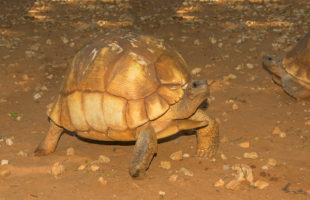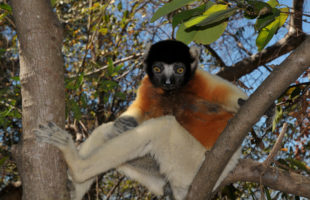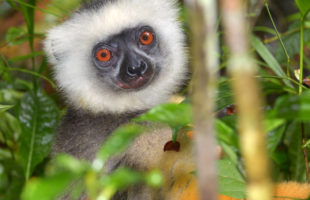Tortoises are popular, both in Madagascar and all over the world. And yet these reptiles on the red island are massively threatened. One of them is the Spider Tortoise (Pyxis arachnoides), named after the beautiful, web-like pattern of its dorsal shell. The older Spider Tortoises get, however, the more the pretty pattern disappears. Really old animals – it is assumed …
LesenSchlagwort-Archiv: rare
The real treasures of Madagascar
An arched, golden shell, relatively long legs and alert, black, shining eyes: That is how the most precious tortoise on Earth looks like. It comes from Madagascar and is named ploughshare tortoise (Astrochelys yniphora) due to the large bony appendage on its breast shell. It serves males to turn over contrahents or females during mating season. And this is quite …
LesenDie singenden Lemuren: Indris
Ihre Gesänge gehören zu den eindruckvollsten, die die Tierwelt zu bieten hat: Man kann die Stimmen der Indris (Indri indri) kilometerweit durch den Wald schallen hören, und sie tragen eine eigentümliche Traurigkeit mit sich. Angeführt und begonnen wird der Gesang stets vom Elternpaar einer Familie, das damit sein Revier absteckt, aber auch mit anderen Familien kommuniziert und vor Bedrohungen wie …
LesenThe second smallest reptile on Earth
It can sit on a matchstick without a problem, and you could almost think that the slightest breeze will blow the fragile pipsqueak off the match: Brookesia micra, the second smallest* reptile on Earth. Despite its few millimeters body lengths, the little, brown leaf chameleon has everything other chameleons need for life, too: Eyes moving to every possible direction, a …
LesenThe angels of the forest: Silky sifakas
The Silky Sifaka (Propithecus candidus) is one of the most beautiful and special lemurs of Madagascar, but also one of the rarest. There are only about 250 sexually mature silk sifakas left in Madagascar, otherwise they do not occur anywhere else in the world. For comparison: In Asia alone there are still around 3000 to 5000 full-grown specimens of tigers …
LesenSecret kings of the North: Golden crowned sifakas
In an incredibly hot, dry and inaccessible area in north-eastern Madagascar live white lemurs, which owe their name to the golden fur on their heads: the Golden Crowned Sifakas (Propithecus tattersalli). The secret kings of the north reach a height of just 95 cm with a weight of 3.5 kg, whereby still further 45 cm of tail come in addition. …
LesenWidely spread, hardly researched: Crowned Sifakas
In the northwest of Madagascar live lemurs, which occur quite frequently, but are nevertheless hardly researched: The Crowned Sifakas (Propithecus coronatus). Their habitat is limited by the two rivers Mahavavy in the southwest and Betsiboka in the northeast. Today, however, there are indications that the species is much more widespread and also populates areas around Tsiroanomandidy, Amboloando (south of Miandrivazo) …
LesenNo life without the Ocotillo: Verreaux’ Sifakas
The Verreaux’ Sifakas (Propithecus verreauxi) lives in the south of Madagascar and belongs to the few lemurs that successfully colonize the hot and hostile spiny forests. It is a very adaptable species that can survive even in very small forest areas. It can even be found in some lowland rainforests in the southeast of the eighth continent. In the northwest, the …
LesenA diadem of fur: Diademed Sifakas
The Diademed Sifaka (Propithecus diadema) is with a total length of 105 cm and a weight between five and seven kilograms one of the largest lemurs of Madagascar and because of its unusual fur colors also one of the most beautiful. His face is framed by long white fur, which looks a bit like a tiara and gave these lemurs …
LesenThe animal that brings death
No other animal in Madagascar has as many myths and fairy tales as the Aye-Aye (Daubentonia madagascariensis). Throughout the northern half of Madagascar, it is fady, which means taboo. Unfortunately, this fady does not mean that the animals are not touched by Madagascans, as with chameleons, for example. Instead, many inhabitants of Madagascar believe that the encounter with an aye-aye …
Lesen MADAMAGAZINE Your Magazine about Madagascar
MADAMAGAZINE Your Magazine about Madagascar










